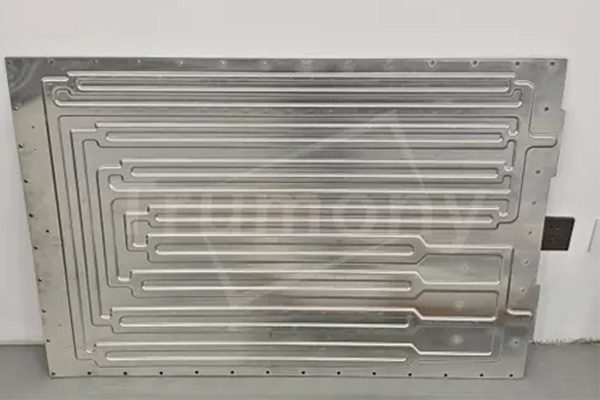Integration of Multiple Cooling Technologies
A single cooling method is unlikely to meet the increasingly stringent heat dissipation requirements of next-generation batteries. As a result, the integration of multiple technologies has become an inevitable trend. For example, combining liquid cooling with phase change materials (PCMs) can significantly enhance thermal management. Under normal operating conditions, the liquid cooling system efficiently dissipates large amounts of heat. When battery temperatures surge under high-load scenarios, the PCMs activate, absorbing substantial latent heat during their phase transition to further stabilize battery temperatures. This results in superior heat dissipation and temperature control.
A notable example is the battery thermal management system developed by the Guangzhou Institute of Energy Conversion of the Chinese Academy of Sciences, which utilizes embedded PCM liquid-cooled composite cold plates. By integrating active and passive cooling methods, this system effectively regulates lithium battery temperatures while offering strong energy-saving potential. Similarly, the combination of air cooling and direct cooling holds promise. The air cooling system, known for its simple structure and low cost, handles routine heat dissipation, whereas the direct cooling system, with its high efficiency and rapid response, can quickly intervene during sudden temperature spikes. Their synergy is expected to enhance heat dissipation while reducing overall system costs and complexity.
Advancing Intelligence and System Integration
The rapid evolution of the Internet of Things, sensor technologies, and artificial intelligence is driving battery cooling systems toward greater intelligence and integration. High-precision sensors will be densely deployed within battery packs to continuously monitor parameters such as temperature, voltage, and current in real time. This data is swiftly transmitted to intelligent control systems that function like a sophisticated brain, using advanced algorithms to dynamically adjust cooling strategies based on actual operating conditions.
For instance, if a localized temperature rise is detected, the system can immediately increase coolant flow or fan speed in the affected area, achieving precise heat management. Moreover, these cooling systems are increasingly integrated with Battery Management Systems (BMS) and overall vehicle thermal management systems to form a cohesive unit. In electric vehicles, for example, the cooling system can coordinate with the vehicle’s thermal management to jointly regulate the heat of batteries, motors, and air conditioning systems. This coordinated approach optimizes energy utilization, lowers consumption, and enhances the vehicle’s overall performance.
Innovations in Materials and Structural Design
The development of new cooling materials represents a critical breakthrough for enhancing cooling system performance. High thermal conductivity graphene composites are drawing significant attention. A team from Anhui Sanlian University, for instance, has integrated ultra-thin graphene films on battery surfaces. Thanks to graphene’s excellent permeability and exceptionally high thermal conductivity, coupled with precision sensors, the system can capture minute temperature changes on the battery surface in real time, providing reliable data for intelligent thermal control.
In addition, new phase change materials are under continuous development, targeting higher latent heat capacity and improved thermal conductivity to further bolster temperature regulation.
Structural innovations are also gaining traction. Microchannel cooling designs improve heat dissipation by minimizing coolant channel sizes, increasing surface area, and enhancing contact between the coolant and the battery. Meanwhile, 3D-printed integrated cooling structures enable the customization of complex, precise cooling pathways tailored to specific battery shapes and heat dissipation needs. This approach maximizes space utilization and improves system-to-battery conformity. A prime example is GAC Aion’s “Phoenix Battery,” which features a three-dimensional thermal management system that expands the heat exchange area by 18 times compared to traditional designs, substantially boosting temperature control rates, efficiency, and overall quality.


